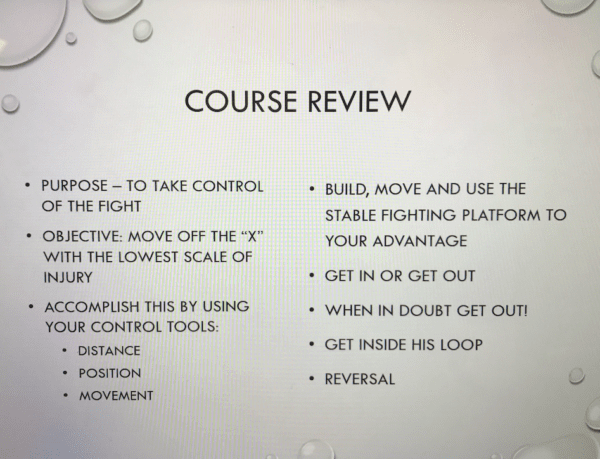
Lots of people carry a handgun for personal self-defense, but as far as self-defense training goes, most people don’t progress beyond a one to three day introductory use-of-firearms course which teaches people how to shoot, but not necessarily how to fight. To the extent the people carrying a firearm are ready to fight, however, they typically spend a lot of their time training to draw (hopefully from concealment,) and put lead in a target as fast as possible. Absolutely essential, yes, but incomplete.
However much we want to stay in ‘condition yellow’ at all times while out and about, the truth is that it’s impossible to maintain perfect awareness 100% of the time, especially when enjoying the company of others, and even more so when trying to corral a couple of young ‘uns. Become inattentive and the proverbial bad guy can be on top of you before you realize there’s a threat. At that point, having some close quarter battle skills is essential.
To that end, Steve Tarani gave a two hour class at the NRA Carry Guard Expo this weekend. His students learned about how to control a fight when confronted with an armed attacker — and in this case, the ‘armed attacker’ was not armed with a firearm, but rather a knife. A single two hour class is not a lot of time when it comes to physical self-defense, but Tarani made the most of it, having his students pair up and run through a series of drills, mostly aimed at getting off the “x” and getting inside the opponent’s OODA loop. When the attack starts at contact distance, putting oneself in position to successfully fight or flee from the situation is key.

Tarani heaped disdain on the idea that hand-to-hand techniques that cause pain would stop an attacker. “I’ve punched lots of guys in the face,” said the muscular 6’5″ operative, and a lot of them just laughed. “Rely on mechanical means to stop the fight.” Cut the attacker’s right biceps and he can’t use his arm. A round between the eyes and…well, you get the picture.
Finally, Tarani appeared to me to be a first-rate instructor. He was clear, encouraged and addressed questions, went at the pace of the students, effectively communicated the fundamentals in a short period of time, and was very easy to talk to. (I would have used the phrase “gentle giant” to describe the man and his mannerisms, if I hadn’t watched him disarm a practice knife from his fellow trainer with the greatest of ease in the blink of an eye.)
I know that the NRA’s Carry Guard instructors and curriculum has gotten some skepticism from the firearms community — expressed by John Boch, who is concerned that their curriculum is untried, and others who worry that the NRA is dissing their home-grown stable of community trainers and organizers. Some of those criticisms may well be valid, but Tarani is a serious teacher for a serious subject that gun carriers all too often neglect, and his record and reputation as a first-rate trainer precede him. Something I can now well attest, having seen him in action.
If you’re looking to improve your own ability to move, react, and solve physical defense problems that don’t necessarily involve a firearm, Steve Tarani is a great resource. I plan to include one of his courses in my own future training plans.




That’s pretty cool. Carrying a knife along with a gun is a good choice.
Good stuff to know. I bet there’s some charge a gun / run from a knife in this training. I’d rather create space from a knife than go with a disarm. I bet an experience operator could take a knife from me close in, but he’d probably get cut in the process.
I believe having a decent weapon, of course helps those that are physically incapable of “hand to hand”. Like having health issues like Heart problems, Spine issues, Cancer, neurological disorders, or being a small woman, etc….These are good reasons for ” ease of use…”
“I’ve punched lots of guys in the face,”
So he’s been running around punching a bunch of people. Not saying it wasn’t justified, but if he can’t avoid trouble any better than that, he’s probably not the go-to guy to learn how to stay safe.
A boxer punches a lot of people in the face, that doesn’t disqualify them from teaching others about boxing. Saying he’s punched a lot of people in the face does not mean the people he punched were not “willing” recipients. Either picked the fight with him or were in a match against him. Additionally I would think it’s better to learn self defense from someone who has punched others in their face than a pacifist or someone who has never been in a fight.
I don’t think he means necessarily in a fighting situation – but ore likely over the course of years of training. He is illustrating point.
I am acquainted with this man, and he has impressed me as a soft-spoken, gentleman – as the write-up says, a gentle giant. He has years of military, law enforcement and civilian training under his belt – as well as lots of Gov’t service. So rather than spout off regarding a likely out-of-context quote, read the man’s bio at https://stevetarani.com/about/brief-bio/ then make an informed judgement.
He is also teaming up with Rob Latham, who you might say knows a bit about firearms and their use, for their Hand-to-Gun classes … http://robleatham.com/training/hand-to-gun-training
In my opinion that would be time and money well spent. Both guys are experts in their field, and both actual gentlemen.
If you’re going to train for hands-on fighting, you need to train for this ALL THE TIME – the muscle memory is there but it dulls very rapidly, as do the muscles themselves.
Comments are closed.